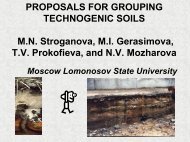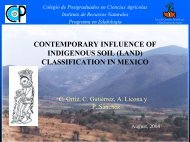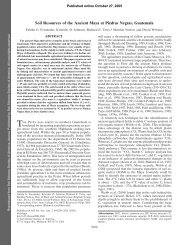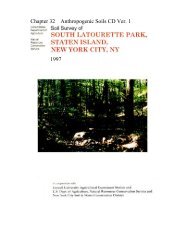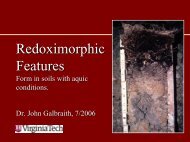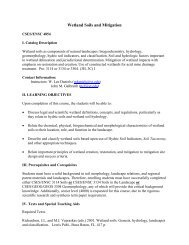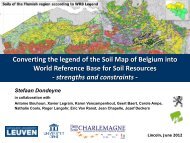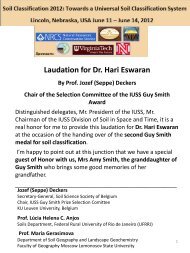Redox and Lithochromic Colors.pdf
Redox and Lithochromic Colors.pdf
Redox and Lithochromic Colors.pdf
Create successful ePaper yourself
Turn your PDF publications into a flip-book with our unique Google optimized e-Paper software.
How to tell <strong>Redox</strong> <strong>Colors</strong> from<br />
<strong>Lithochromic</strong> <strong>Colors</strong><br />
Soil Training Day<br />
9-27-06
Grey <strong>Colors</strong> – the process that<br />
causes them<br />
• You can get gray colors several ways –<br />
– Saturation <strong>and</strong> reduction of Mn <strong>and</strong> Fe<br />
– Primary mineral color in rocks<br />
– Intense, long term leaching from an A or E<br />
horizon<br />
– Unmodified, unsaturated gray s<strong>and</strong> parent<br />
material
Red <strong>Colors</strong><br />
– the processes that cause them<br />
1. Release of Fe-bearing compounds from<br />
primary weathering.<br />
2. Concentration of oxidized Fe minerals.<br />
3. Precipitation of reduced Fe that comes<br />
into contact with gaseous oxygen.
Black <strong>Colors</strong><br />
– the processes that cause them<br />
1. Release of dark-colored compounds<br />
from primary weathering.<br />
2. Concentration of oxidized Mn minerals.<br />
3. Precipitation of reduced Mn that comes<br />
into contact with gaseous oxygen.<br />
4. Pieces of charcoal or coal.
How to tell the process?<br />
• To rule out mistaking weathering colors<br />
from redox colors, look for the originial<br />
rock structure, rocks, <strong>and</strong> mineral structures.
How to Recognize <strong>Redox</strong>imorphic Features<br />
1. When three colors occur within a soil horizon, <strong>and</strong> they<br />
are not associated with a rock fragment or rock<br />
structure or rock mineral weathering.<br />
2. The soil matrix is usually gray or brown.<br />
3. The color lighter (higher value) or grayer (lower<br />
chroma) than the soil matrix is the depletion.<br />
4. The color right next to the depletion that is redder,<br />
oranger, or yellower than the matrix is the<br />
concentration.<br />
5. <strong>Redox</strong> features gradually change colors.
<strong>Redox</strong><br />
Depletions<br />
A review of their<br />
formation<br />
(Fig. 9 from Vepraskas 1995)<br />
concentration
<strong>Redox</strong><br />
Concentrations<br />
A review of their<br />
formation<br />
(Fig. 9 from Vepraskas 1995)
<strong>Redox</strong> Features<br />
Conc. <strong>and</strong> Depl. formation<br />
Concentration Zone Fe +++<br />
Soil Matrix<br />
Old Root Channel<br />
Depletion Zone Fe ++<br />
Formation of redox depletions <strong>and</strong> concentrations along root channels
Endosaturation<br />
evidence of an apparent water table<br />
in all layers from 2m up through<br />
the upper saturated layer<br />
Water from below (endo)
Episaturation<br />
Water from on top (epi)<br />
Ap<br />
BA<br />
Bt<br />
E/Btc<br />
Btx<br />
Evidence of apparent water<br />
table in a horizon above an<br />
unsaturated horizon<br />
This horizon is seasonallysaturated<br />
from perched water<br />
Fragipan = Perching horizon,<br />
unsaturated
NOTE:<br />
1. Older depletions can become reoxidized or<br />
replenished in oxidized Fe, leaving the<br />
concentrations behind. This is often seen in<br />
coastal plain soils, when a horizon has<br />
concentrations but no depletions, but the<br />
horizon below has both.<br />
2. Manganese <strong>and</strong> Fe can become cemented if<br />
the concentration gets high enough, as it did in<br />
many past climates. The concretions left<br />
behind may not tell us much about today’s soil<br />
climate, but soft black Mn-Fe masses <strong>and</strong> thin<br />
black aggregate coatings tell us that the soil<br />
reduction processes are current.
How to Recognize <strong>Lithochromic</strong> <strong>Colors</strong><br />
1. Use a h<strong>and</strong> lens to see if the color pattern has sharp edges.<br />
Rocks <strong>and</strong> minerals weathering in place often do not<br />
change color gradually.<br />
2. See if the color pattern can be extracted with a knife.<br />
3. Look for rock fragments <strong>and</strong> rock-controlled structure.<br />
4. <strong>Redox</strong> features should cross rock-structural boundaries,<br />
while L. C. should follow the rock-structure or mineral<br />
cleavage plains.<br />
5. Coastal plains sediments have no rock structure but the<br />
color patterns often follow stratification from the original<br />
depositions <strong>and</strong> subsequent secondary mineral precipitation<br />
of Mn <strong>and</strong> Fe leached from above.
Rock<br />
Gray Soil<br />
Oxidative Color Change<br />
+ 0 2<br />
Processes<br />
Oxidation<br />
<strong>Redox</strong><br />
concentration<br />
+ 02 +H2O +H<br />
Primary weathering<br />
Oxidation, hydrolysis, hydration<br />
Weathered<br />
Rock
<strong>Lithochromic</strong> colors
<strong>Lithochromic</strong> <strong>Colors</strong> <strong>and</strong> Mottles<br />
• Color patterns (may be<br />
any color from white<br />
to gray to black to red)<br />
inherited from<br />
minerals released from<br />
weathering of rock
Some of each



